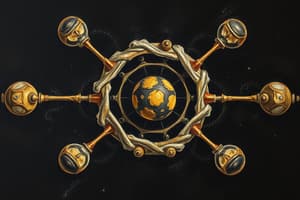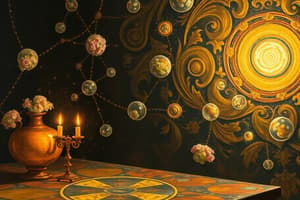Podcast
Questions and Answers
John Dalton proposed that all substances are made of atoms, which are visible and finite.
John Dalton proposed that all substances are made of atoms, which are visible and finite.
False (B)
What is the significance of atomic number (Z) in identifying an element?
What is the significance of atomic number (Z) in identifying an element?
It represents the number of protons in an atom's nucleus.
The central part of an atom, which contains protons and neutrons, is called the ______.
The central part of an atom, which contains protons and neutrons, is called the ______.
nucleus
Match the following scientists with their contributions to atomic theory:
Match the following scientists with their contributions to atomic theory:
Which of the following best describes the concept of electron shells?
Which of the following best describes the concept of electron shells?
Electrons have a positive charge and are located in the nucleus.
Electrons have a positive charge and are located in the nucleus.
Who discovered the neutron, and in which year?
Who discovered the neutron, and in which year?
According to Bohr's model, electrons occupy different ______ in an atom.
According to Bohr's model, electrons occupy different ______ in an atom.
What is the role of protons in an atom?
What is the role of protons in an atom?
What are atoms primarily composed of?
What are atoms primarily composed of?
According to Dalton's atomic theory, atoms can be divided into smaller particles.
According to Dalton's atomic theory, atoms can be divided into smaller particles.
What is the term for the number of protons in an atom's nucleus?
What is the term for the number of protons in an atom's nucleus?
The particles in the nucleus are protons and __________.
The particles in the nucleus are protons and __________.
Match the atomic models to their respective proposers:
Match the atomic models to their respective proposers:
Which of the following statements about electrons is true?
Which of the following statements about electrons is true?
Neutrons have a positive charge.
Neutrons have a positive charge.
Who discovered the electron and in which year?
Who discovered the electron and in which year?
In an atom, the __________ is the central core that contains protons and neutrons.
In an atom, the __________ is the central core that contains protons and neutrons.
Which of the following best describes atomic number?
Which of the following best describes atomic number?
Flashcards are hidden until you start studying
Study Notes
परमाणु की परिभाषा
- परमाणु: एक मूलभूत कण जो किसी भी तत्व की सबसे छोटी इकाई है।
- यह रासायनिक गतिविधियों में भाग लेता है और पदार्थ की पहचान स्थापित करता है।
परमाणु सिद्धांत
- डेमोक्रिटस: परमाणु का पहला विचार, इन्हें "अणु" कहा।
- जॉन डाल्टन:
- सभी पदार्थ अणुओं से बने होते हैं।
- अणु अदृश्य और असीमित होते हैं।
- अलग-अलग तत्वों के अणु भिन्न होते हैं।
- रासायनिक प्रतिक्रिया में अणु का पुनर्गठन होता है।
इलेक्ट्रॉन की संरचना
- इलेक्ट्रॉन: परमाणु में नकारात्मक चार्ज वाला कण।
- इलेक्ट्रॉनों की परतें (शेल) परमाणु के चारों ओर स्थित होती हैं।
- मुख्य शेल: K, L, M, N आदि, जिसमें इलेक्ट्रॉन की अधिकतम संख्या निर्धारित होती है (2n²)।
परमाणविक संख्या
- परमाणविक संख्या (Z): किसी तत्व के परमाणुओं में प्रोटॉन की संख्या।
- तत्व की पहचान के लिए महत्वपूर्ण है।
- उदाहरण: हाइड्रोजन का परमाणविक संख्या 1, हीलियम का 2।
न्यूक्लियस की संरचना
- न्यूक्लियस: परमाणु का केंद्रीय भाग।
- इसमें प्रोटॉन (पॉजिटिव चार्ज) और न्यूट्रॉन (न्यूट्रल) होते हैं।
- न्यूक्लियस की कुल मात्रा का लगभग 99.9% भाग न्यूक्लियस में होता है।
परमाणु मॉडल
- थॉमसन का मॉडल: "प्लम पुडिंग" मॉडल, जिसमें इलेक्ट्रॉन सकारात्मक चार्ज में बिखरे होते हैं।
- रदरफोर्ड का मॉडल: न्यूक्लियस के चारों ओर इलेक्ट्रॉन घूमते हैं।
- बोह्र का मॉडल: इलेक्ट्रॉन की परतों और ऊर्जा स्तरों के साथ।
इलेक्ट्रॉन, प्रोटॉन एवं न्यूट्रॉन की खोज
- इलेक्ट्रॉन: 1897 में जे.जे. थॉमसन द्वारा खोजा गया।
- प्रोटॉन: 1919 में अर्नेस्ट रदरफोर्ड द्वारा खोजा गया।
- न्यूट्रॉन: 1932 में जेम्स चैडविक द्वारा खोजा गया।
Definition of an Atom
- An atom is the fundamental particle that represents the smallest unit of any element.
- Atoms participate in chemical reactions and establish the identity of substances.
Atomic Theory
- Democritus introduced the first idea of atoms, referring to them as "atomos."
- John Dalton's contributions include:
- All matter is composed of atoms.
- Atoms are invisible and indivisible.
- Atoms of different elements are distinct from one another.
- Chemical reactions involve the rearrangement of atoms.
Electron Structure
- Electrons are negatively charged particles found within atoms.
- Electron shells, or layers, are arranged around the atom.
- Principal shells include K, L, M, N, etc., with a maximum electron capacity defined by the formula (2n²).
Atomic Number
- The atomic number (Z) represents the number of protons in an atom of an element.
- It is crucial for identifying the element.
- Examples include: Hydrogen has an atomic number of 1, and Helium has an atomic number of 2.
Structure of the Nucleus
- The nucleus is the central part of the atom.
- It contains protons (positively charged) and neutrons (neutral).
- About 99.9% of the atom's mass is concentrated in the nucleus.
Atomic Models
- Thomson's model, known as the "plum pudding" model, depicted electrons dispersed within a positively charged "soup."
- Rutherford's model introduced the concept of electrons orbiting around the nucleus.
- Bohr's model established the notion of electron layers and energy levels.
Discoveries of Electrons, Protons, and Neutrons
- The electron was discovered by J.J. Thomson in 1897.
- The proton was identified by Ernest Rutherford in 1919.
- The neutron was discovered by James Chadwick in 1932.
Definition of Atom
- Atom: The smallest particle necessary to retain the properties of an element.
- Composed of protons, neutrons, and electrons.
Atomic Theory
- Dalton's Atomic Theory:
- All matter is made up of atoms.
- Atoms are indivisible and exist as molecules.
- Atoms of different elements are distinct and possess different properties.
Electron Structure
- Electrons: Negatively charged particles located in the outer shell of the atom.
- Organized into layers based on energy levels.
Atomic Number
- Atomic Number: The number of protons in an atom of an element.
- Serves as the primary identifier for elements, e.g. Hydrogen (1), Carbon (6), Oxygen (8).
Structure of Nucleus
- Nucleus: The central part of an atom, consisting of protons and neutrons.
- Protons: Positively charged particles located within the nucleus.
- Neutrons: Neutrally charged particles found within the nucleus.
Atomic Models
- Thomson's Model: Depicts the nucleus as a "pudding" with embedded electrons.
- Rutherford's Model: Implies a nucleus at the center, with electrons orbiting around it.
- Bohr's Model: Suggests electrons exist in layers around the nucleus, corresponding to specific energy levels.
Discovery of Electrons, Protons, and Neutrons
- Electron Discovery: Identified by J.J. Thomson in 1897.
- Proton Discovery: Identified by Ernest Rutherford in 1919.
- Neutron Discovery: Identified by James Chadwick in 1932.
Studying That Suits You
Use AI to generate personalized quizzes and flashcards to suit your learning preferences.




